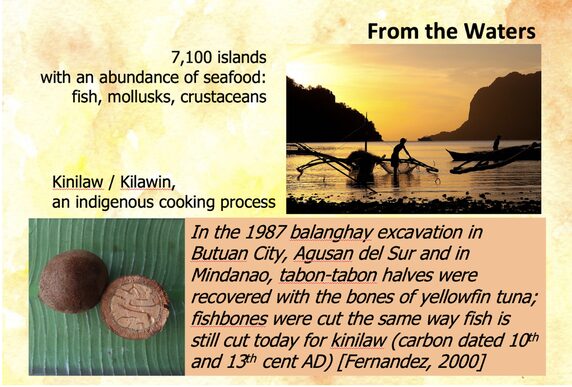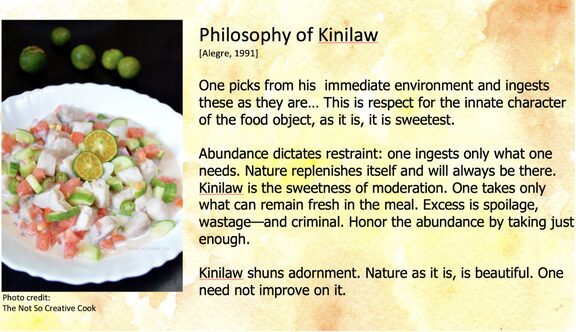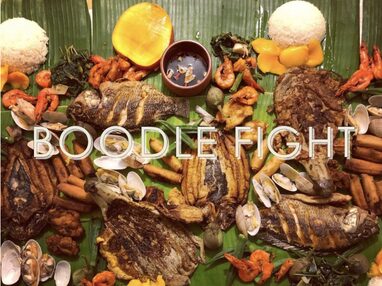Sama-sama Magsalu-salo
Written by Darren Sana, Pia Arboleda, and Angeli Callo
Background
This module introduces learners to the diverse Philippine food landscape, shaped by the country’s geography, history, and various indigenous groups. We will also discuss the concepts of “salu-salo” and “boodle fight,” emphasizing the strong value of community centered around shared meals.
Motivating Activity: Exploring Filipino Cuisine
This activity introduces you to Filipino food, encouraging personal reflection and dispelling common misconceptions through an imaginative scenario of a Filipino party.
1. Initial Impressions of Philippine Food
- Teacher asks:
- Are you familiar with Philippine food? Have you tried Filipino food?
- If yes, when and where? Did you like it or not? Why/Why not?
- If not, look up Filipino food on Google and share what you found.
- Common Examples and Misconceptions:
- Filipino food is oily, salty, or unhealthy.
- Everything is fried.
- Filipinos eat balut (duck egg), black dog, and dinuguan (“chocolate meat”).
- What do you think of these misconceptions? Does this coincide or not with your experience of Filipino food?
2. Imagining a Filipino Party
- Demonstrate:
- Why do you think we understand Filipino food this way? We are socialized into believing these concepts because we might have heard it from parents, friends, and posts on social media.
- Imagine a Filipino party and describe it. What do you hear, see, smell?
- If you haven’t been to a Filipino party, please listen to the stories of your peers and share if you have any similar experience in your own culture.
Processing Activity: The Filipino Food Landscape
This activity provides a brief background on the Filipino food landscape and demonstrates how it reflects the Philippine worldview.
1. Lecture: Key Aspects of Philippine Cuisine
The teacher will briefly lecture about the following topics:
- Philippine Food Landscape:
- What does the geography of the Philippines look like and how does this affect the food landscape? (Emphasize that the Philippines has both coastal and mountain regions.)
- Discuss the different indigenous groups present in the Philippines and give examples of how they treat food differently in their tribes. (See examples below in a dedicated section or table.)

- Kinilaw (Philosophy):
- Explain the concept of restraint in the presence of abundance and how this kind of philosophy relates to “fresh food” like the kinilaw.
- Explain different regional variations of Kinilaw/Kilawin and relate this to the geographic landscape of the Philippines.

- Importance of Rice: Start a discussion on the importance of Rice in the Philippine community.
- Outside Influences: Discuss the outside influences that helped shape Filipino food today (e.g., Spanish, Chinese, Malay, etc.).
2. Videos on Philippine Cuisine
The teacher will play the following videos on Philippine cuisine to provide visual and auditory context.
- Bizarre Foods (Embed video here)
- How to cook Pinikpikan (Embed video here)
- Ginamos na Baboy (Embed video here)
3. Guide Questions for Discussion: Unique Philippine Cuisine
- What do you think makes Philippine cuisine unique?
- How can you make a Filipino version of any recipe? Can you think of examples?
- What is the difference between Philippine cuisine in comparison to a cuisine you are more familiar with (Spanish, Chinese, etc.) based on the three videos you just watched?
Culminating Activity: Food as a Social Activity
Taking the lesson a step further, this activity will show how the concept of eating in the Philippines is a social activity, indicative of the strong sense of community found across the archipelago.
1. Concepts of “Salu-salo” and “Boodle Fight”
The teacher will discuss the following concepts:
- Salu-salo:
- What is salu-salo?
- From the root word salu, it’s a form of gathering involving food to share, usually in celebration of an event or achievement; to honor a person/persons; or to simply indulge in food and treasure each other’s company.
- Boodle Fight:
- It is a form of salu-salo that usually involves no utensils and the traditional Filipino way of eating using your hands, also known as kamayan.
- A combination of dishes (ulam) is usually scattered and spread out evenly on top of rice using layers of banana leaves as a form of plato or plates.
- You may also have small bowls on the side for sawsawan (dipping sauces) and fruits on the other side paired with the dish while eating Filipino style.

2. Language Component: My Favorite Food
Practice describing your favorite food in Filipino.
___________ ang paborito kong pagkain. (My favorite food is ________ )
Masarap ang ___________. (The ____ is delicious.)
3. Planning a “Salu-salo” Event
Imagine you are responsible for preparing a salu-salo for any occasion (e.g., Christmas dinner or a Graduation party). How would you do it?
Consider the following factors:
- What is the occasion?
- Who are you inviting?
- Would you do the salu-salo in the traditional Filipino style? If not, what kind of style?
- What dishes are you going to prepare?
- What ingredients are you going to use? Where will you purchase them from?
- Think of a fun activity to make the party enjoyable and tell the class about it.
Assignment: Write a two-paged essay about this assignment.
4. Reflection & Community
Reflect on the deeper meaning of food and community.
- Guide Questions:
- What is the importance of food in creating a sense of community?
- Reflect on your own experiences. What role does food play in your life, your community?
Enrichment Activity
- Read the following article and reflect on the following questions: How can the study of food and preservation of practices surrounding it help the community preserve and document indigenous knowledge?
- Write a short essay about your fondest food memory:
- What did you hear?
- What did the food look like?
- What did it smell like?
- How did it taste?
- What did it feel like?
- What was the occasion?
- Who were there with you?
- Use at least 3-5 Filipino words you have learned so far.
Resources / Books
- Palayok – Doreen Fernandez (No link)